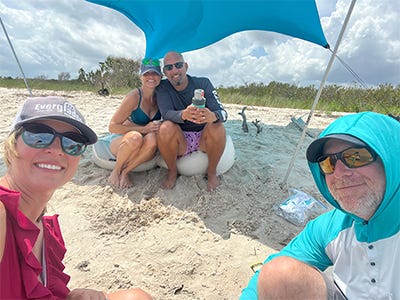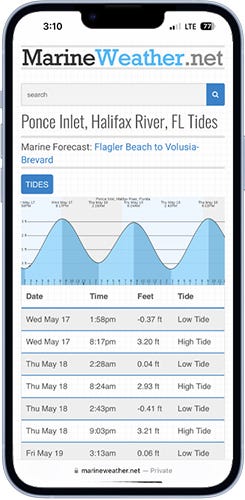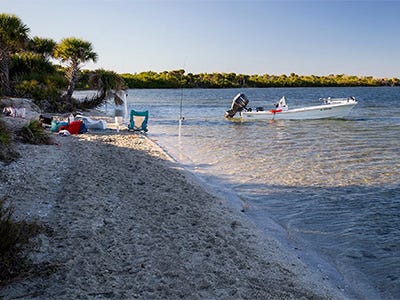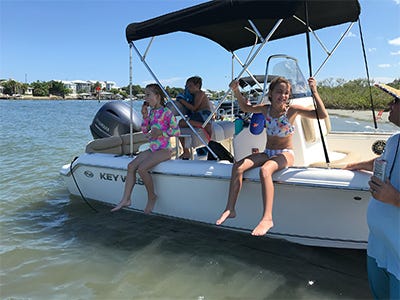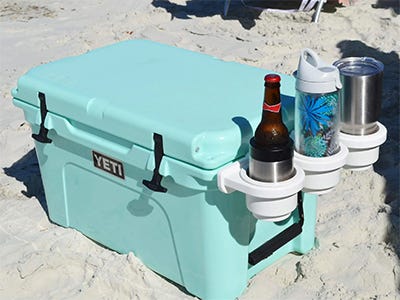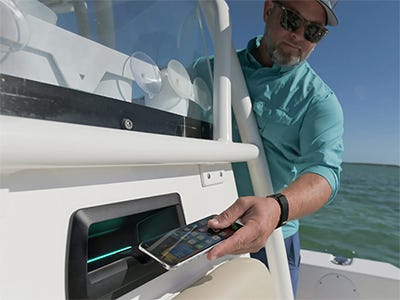

The internet is overflowing with boating checklists, most of them belaboring the obvious: PFDs, distress signals, paperwork, drain plugs and so on. Let’s change that up with some lists of stuff you actually might not think of on your own or be able to find enumerated in 50 other online articles — “pro tips,” so to speak.
Contents
- 1. How to Make Your Day Easier, Safer and More Fun
- 1.1 Small Shovel
- 1.2 Access To Weather and Tide Info
- 1.3 A Second Anchor
- 1.4 Garbage Bags
- 1.5 Bean Bags or Inflatable Chairs
- 1.6 Real Shoes
- 2. Boo-Boo Remedies
- 3. Cool Sandbar Gear
- 3.1 Gunwale-Mount Cup Holders and Trays
- 3.2 Beach Cup Holders and Trays
- 3.3 Dedicated Device Charger
- 3.4 Swim Ladder
How to Make Your Day Easier, Safer and More Fun
For the first installment, let’s look at a good, old-fashioned family fun day at the sandbar, island or boat-in beach. Yes, you need sunscreen. But here are a few more things you might not have thought of that will make your day easier, safer and more fun.
Small Shovel
Some kind of small but effective digging tool can come in handy in lots of ways.
For example, bags or buckets of sand are generally more effective than tent stakes for securing guylines on shelters and shades on the beach, and they’re a lot easier to fill with a metal shovel than by hand or with a plastic kids’ toy.
Likewise, fluke-style anchors can be difficult to set solidly in hard sand on the beach or sandbar, but dig a hole for them and they’re bombproof.
Folding “entrenching tools” are nice because they’re compact and easy to stow on board. Short-handled regular shovels are nice too. Some kind of small but effective digging tool can come in handy in lots of ways. Folding “entrenching tools” are nice because they’re compact and easy to stow on board. Short-handled regular shovels are nice too.
Access To Weather and Tide Info
Sure, technically this is right on your phone, assuming you have cellular service. But finding the information you need is a lot easier at home than on a windy, sunblasted sandbar with sunscreen on your hands and possibly a beverage or two in your belly.
So pull up browser windows on your phone the night before your trip with the relevant tide charts and the local weather (including radar so you can see what those afternoon storms are up to).
While you’re at it, make sure you actually understand the tide info you’re looking at. Some tide tables and charts are less than intuitive, and knowing whether the water is rising or falling while you’re at the sandbar can make or break your day (and the following night). Finally, none of this does any good if your phone dies, so fully charge it for the day and, better yet, make sure you have a (working) 12V or USB outlet on board.
Knowing whether the water is rising or falling while you’re at the sandbar can make or break your day.
Some tide tables and charts are less than intuitive, and knowing whether the water is rising or falling while you’re at the sandbar can make or break your day.
A Second Anchor
Depending on your boat, where you’re going and the day’s conditions, you might be able to get away with just beaching your boat bow-first. But that means you’ll need to pay close attention to the tide.
It also leaves your boat vulnerable to swamping from wakes and wind waves. That’s because with your bow on the sand, your stern can’t ride up and over waves.
With bigger boats, rougher conditions and/or more tidal movement, you may need to anchor bow-out, and that will require, at the bare minimum, your main anchor plus a fairly long line off the stern tied to something solid on shore. Really, though, you should have at least a “beach anchor” of some kind — a fiberglass or metal spike or screw-in device — and preferably a second “real” anchor.
With bigger boats, rougher conditions, and/or more tidal movement, you may need to anchor bow-out, and that will require, at the bare minimum, your main anchor plus a fairly long line off the stern.
Garbage Bags
Sandbar days produce lots of garbage, especially with kids along, but most recreational boats don’t have functional trash receptacles. Besides, chances are good you’ll be on the sand most of the day and won’t want to go out to the boat every time you have an empty chip bag to throw away.
So trash gets stashed — dropped in the cooler, stuck in side pockets of beach bags, tucked under chair legs, etc. Then, at the end of the day, you have to find and collect it all. A couple of garbage bags will make cleanup easier and also reduce the chances of trash getting loose and blowing down the beach or into our waterways.
Bean Bags or Inflatable Chairs
Not truly a must, just a plus, bean bags and inflatable chairs are great for sandbar days because they work just as well on the boat as off. Sure, you can take your folding metal beach chairs or camp chairs, but you can’t use them on the boat, and they’re awkward to stow, corrosion-prone, and have lots of fiberglass-scratching angles and edges. Marine bean bags and inflatable seats, on the other hand, are great both on the boat and on the sand.
Inflatables have the added advantage of being compact and easy to stow when deflated. Related tip: If you’re going to depend on an electric air pump for inflatable chairs, kid toys, paddleboards or anything else, test it on the boat the night before. Both electric air pumps and 12V cigarette lighter-style outlets on boats are notoriously finicky.
Marine bean bags and inflatable seats are great both on the boat and on the sand.
Real Shoes
Flip-flops are great for lounging around, but in the event something goes awry, having a pair of substantial, lace-up shoes stashed on board can make life a lot easier.
Slippery flops are less than ideal for wading, walking any distance on uneven ground, muscling a boat off the sand and so on.
Boo-Boo Remedies
If you take young kids to the sandbar, they will get hurt. Every. Single. Time.
They will trip and skin their knees; they will get stung by something in the water, in the air or on the ground; they will step on sharp shells; they will stub their toes on somebody’s anchor; they will get sand and/or sunscreen in their eyes; they will get hit in the ear with a Frisbee and so on forever.
Now, there’s nothing wrong with those ready-made first-aid kits in a red plastic box from the corner drug store, but they don’t contain everything you need. In addition to a supply of band-aids and gauze, think about adding:
- Topical antihistamine or hydrocortisone cream for stings and bites
- One more cold packs in the cooler
- White vinegar for rinsing (most) jellyfish stings
- Saline eye drops for flushing sand out of eyes
- A spray bottle of clean fresh water, great for rinsing sand off faces, scrapes etc.
- A clean hand towel kept in reserve for cleaning off sand, etc.
- Aloe vera gel or lotion for trips home with sunburns
- Reliable distractions, like favorite treats, games, etc.
Cool Sandbar Gear
Just like having the right gear can make your boat better for fishing or skiing, innovative accessories can also go a long way toward optimizing your boat for sandbar-ing (if that’s a word). Here are a few Boat Outfitters favorites.
Gunwale-Mount Cup Holders and Trays
Most boat cup holders are hard to reach if you’re not actually in the boat. What you need instead is cup holders and trays that mount on the gunwales.
There are lots of options here, ranging from the simple and inexpensive Rod Spike Cup Holder, which instantly transforms any flush-mount rod holder to a cup holder, to the elaborate Docktail Bar. Rod holder-mount and V-Lock cutting boards also hold drinks and snacks effectively. Or, for a more permanent solution, swap out your standard flush-mount rod holders for Rod Cup Combo Holders.
Beach Cup Holders and Trays
If you’re on the beach instead of in the water near your boat, you’ll still need somewhere secure for drinks and snacks. One option is to use a screw-in sand spike as a base for something like the Drink Bar with Serving Tray.
Another is to add a tray, cutting board and/or drink caddy to your cooler. BONUS: Sand spikes are also useful as the bases of our Sand Spike Beer Pong Set.
Dedicated Device Charger
Sure, you can plug your phone charger cord into a 12V outlet and drop your phone into a cup holder. But a dedicated wireless charger is more dependable and safer.
Wireless charging means not having to keep track of cords, which means fewer possible failure points. Wireless chargers are also waterproof, and many also keep your phone out of the sun spray.
Swim Ladder
Climbing aboard a beached or anchored boat without a ladder is no fun, especially in front of a few dozen new friends. Climbing over the transom is also a good way to injure yourself by hitting your leg or foot on a prop or trim tab.
A substantial swim ladder makes the process both safer and easier. Getting over the bow of a beached boat of any size is hard too. Short of mounting a folding ladder on the bow, you can use a cooler as a stepstool or even take a folding plastic stepstool, available for $20 or so at most big box stores.

